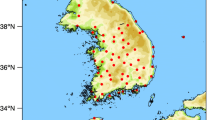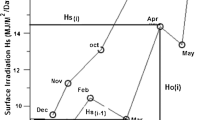Abstract
We examined the spatial and temporal characteristics of tropical nights (TNs) in Seoul to determine whether land use factors increase the frequency of TN. The number of TN was derived using data from 23 Automatic Weathering Stations (AWS) in Seoul for 1998–2006, and 26 AWS in Seoul and nine Gangnam-gu stations for 2007–2013. The results show that the number of TN recorded in the Seoul Automatic Synoptic Observation System (ASOS) gradually increased from 1971 to 2013. TN occurred most frequently in early August, followed by mid-August, late July, late August, mid-July, early July, early September, and mid-September. The largest annual average difference occurred between Gangnam Station and Yeomgokdong, in spite of the short physical distance (4.5 km) between two stations at Gangnam-gu. There were more TNs at high-rise buildings and commercial business district (CBD) areas with low sky view factors (SVF) than in mountain foothill areas.












Similar content being viewed by others
References
Bhattacharya, S. (2003). European heat wave caused 35,000 deaths. New Scientist, 10(10), 03.
Choi, H. (2004). Topical night (nocturnal thermal high) in the mountainous coastal city. Journal of Environmental Sciences, 13(11), 965–985.
Choi, G. Y., & Kwon, W. T. (2005). Spatial-temporal patterns and recent changes of TN phenomenon in South Korea. Journal of Geophysical Society, 39(5), 711–721 (Written in Korean).
Eliasson, I. (1996). Urban nocturnal temperatures, street geometry and land use. Atmospheric Environment, 30(3), 379–392.
Feng, S., Hu, Q., & Qian, W. H. (2004). Quality control of daily meteorological data in China, 1951-2000: a new dataset. International Journal of Climatology, 24, 853–870.
Gal, T., Lindberg, F., & Unger, J. (2009). Computing continuous sky view factors using 3D urban raster and vector databases: comparison and application to urban climate. Theoretical and Applied Climatology, 95(1-2), 111–123.
Gallo, K. P., Owen, T. W., Easterling, D. R., & Jamason, P. F. (1999). Temperature trends of the US historical climatology network based on satellite-designated land use/land cover. Journal of Climate, 12(5), 1344–1348.
Ha, K. J., & Yun, K. S. (2012). Climate change effects on TN days in Seoul, Korea. Theoretical and Applied Climatology, 106(2), 225–254.
Harasawa, H. (2006). Effects of global warming on civil life in Japan. Global Environmental Research, 10(2), 219–226.
He, J. F., Liu, J. Y., Zhuang, D. F., Zhang, W., & Liu, M. L. (2007). Assessing the effect of land use/land cover change on the change of urban heat island intensity. Theoretical and Applied Climatology, 90(3-4), 217–226.
Kim, Y. H., & Baik, J. J. (2004). Daily maximum urban heat island intensity in large cities of Korea. Theoretical and Applied Climatology, 79(3-4), 151–164.
Kim, Y. H., & Baik, J. J. (2005). Spatial and temporal structure of the urban heat island in Seoul. Journal of Applied Meteorology Society, 44(5), 591–605.
Kim, Y. J., Kim, B. J., Shin, Y. S., Kim, H. W., Kim, G. T., & Kim, S. J. (2019). A case study of environmental characteristics on urban road-surface and air temperatures during heat-wave days in Seoul. Atmospheric and Oceanic Science Letters, 12(4), 261–269.
Korea Meteorological Administration (KMA) (2009). http://web.kma.go.kr/notify/focus/list.jsp?bid=focus&mode=view&num=11. Accessed 3 February 2014. (Written in Korean)
Korea Meteorological Administration (KMA) (2011). Climatological Normal of Korea. http://www.kma.go.kr/down/Climatological_2010.pdf. Accessed 6 February 2014. (Written in Korean)
Korea National Institute of Environmental Research (2010). Korea National Institute of Environmental Research. http://www.nier.go.kr/NIER/EgovMovePageMain.do?linkPage=nier-nf-03&nId=3473&Command=READ. Accessed 24 February 2014.
Kwon, M. H., Jhun, J. G., & Ha, K. J. (2007). Decadal change in East Asian summer monsoon circulation in the mid-1990s. Geophysical Research Letters, 34, L21706.
Landsberg, H. E. (1981). The urban climate (Vol. 28). Academic Press.
Moon, Y. S., Lee, H. L., Hwang, E. J., & Chae, H. J. (2006). Analysis on characteristics of TN based on urban heat island effect in Seoul. Journal of Environment Studies and Education, 10, 35–55 (Written in Korean).
Oke, T. R. (1987). Boundary layer climates (2nd ed.pp. 3–4). New York: Routledge.
Park, W. S., & Seo, M. S. (2011). Characteristics and trends of TN occurrence in South Korea for recent 50 years (1958-2007). Atmosphere, Korean Meteorological Society, 21(4), 361–371 (Written in Korean).
Park, J. K., Lu, R. Y., Li, C. F., & Kim, B. B. (2012). Interannual variation of TN frequency in Beijing and associated large-scale circulation background. Advances in Atmospheric Sciences, 29(2), 295–306.
Pauleit, S., Ennos, R., & Golding, Y. (2005). Modeling the environmental impacts of urban land use and land cover change-a study in Merseyside, UK. Landscape and Urban Planning, 71(2), 295–310.
Seoul Metropolitan Government (2013). Seoul Statistical Yearbook, 53th. http://stat.seoul.go.kr/jsp2/WWS9/WWSDS9003.jsp. Accessed 3 November 2014.
Yamashita, S., Sekine, K., Shoda, M., Yamashita, K., & Hara, Y. (1986). On relationships between heat island and sky view factor in the cities of Tama River basin, Japan. Atmospheric Environment (1967), 20(4), 681–686.
Zheng, H. Y., Jin, W. C., & Lee, K.-S. (2011). Urban air temperature difference between central business district and suburban hill footslope village. Journal of Korea Society of Environmental Restoration Technology, 14(1), 67–76.
Funding
This research was funded by the Basic Research of National Research Foundation of Korea (2013R1A1A2010007) and by Samsung Academic Research (S-2012-0796-000-1).
Author information
Authors and Affiliations
Corresponding author
Additional information
Publisher’s note
Springer Nature remains neutral with regard to jurisdictional claims in published maps and institutional affiliations.
Rights and permissions
About this article
Cite this article
Zheng, H., Yu, J., Lim, J. et al. Spatial and temporal characteristics of tropical nights in Seoul. Environ Monit Assess 192, 669 (2020). https://doi.org/10.1007/s10661-020-08608-4
Received:
Accepted:
Published:
DOI: https://doi.org/10.1007/s10661-020-08608-4




